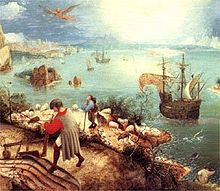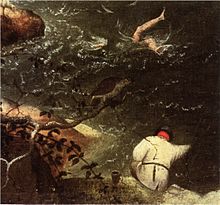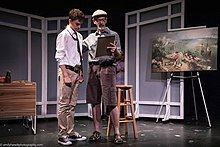Bruegel the Fall of Icarus Museum of Fine Arts
| Mural with the Fall of Icarus | |
|---|---|
 | |
| Artist | Pieter Bruegel the Elder |
| Twelvemonth | c. 1560 |
| Medium | oil on sheet |
| Dimensions | 73.5 cm × 112 cm (28.9 in × 44 in) |
| Location | Royal Museums of Fine Arts of Belgium, Brussels |
Mural with the Fall of Icarus is a painting in oil on sail measuring 73.5 past 112 centimetres (28.9 in × 44.1 in) currently displayed in the Royal Museums of Fine Arts of Belgium in Brussels. It was long thought to be past the leading painter of Dutch and Flemish Renaissance painting, Pieter Bruegel the Elder. Even so, post-obit technical examinations in 1996 of the painting hanging in the Brussels museum, that attribution is regarded as very doubtful, and the painting, perchance painted in the 1560s, is now usually seen as a adept early on copy by an unknown artist of Bruegel'due south lost original, maybe from near 1558. According to the museum: "It is doubtful the execution is by Bruegel the Elder, but the composition can be said with certainty to be his",[one] [2] although recent technical research has re-opened the question.
Largely derived from Ovid, the painting is described in Due west. H. Auden's famous poem "Musée des Beaux-Arts", named afterwards the museum in Brussels which holds the painting, and became the subject of a poem of the same name by William Carlos Williams, as well as "Lines on Bruegel's 'Icarus'" by Michael Hamburger.[3]
Clarification [edit]

Landscape with The Fall of Icarus, ca. 1590–95, oil on wood (63 by 90 centimetres (25 in × 35 in)), Circumvolve of P. Bruegel the Elder, Museum van Buuren, Brussels, Belgium
In Greek mythology, Icarus succeeded in flying, with wings fabricated by his father Daedalus, using feathers secured with beeswax. Ignoring his father'south warnings, Icarus chose to fly too close to the lord's day, melting the wax, and fell into the sea and drowned. His legs tin can be seen in the water just below the transport. The dominicus, already half-set on the horizon, is a long way away; the flying did not achieve anywhere near it. Daedalus does not appear in this version of the painting, though he does, still flying, in the van Buuren one (see left).
The ploughman, shepherd and angler are mentioned in Ovid's account of the legend; they are: "astonished and call back to see gods approaching them through the aether",[4] which is not entirely the impression given in the painting. The shepherd gazing into the air, away from the ship, may be explained by another version of the composition (see beneath); in the original work there was probably also a figure of Daedalus in the sky to the left, at which he stares. There is also a Flemish maxim (of the sort imaged in other works by Bruegel): "And the farmer continued to turn..." (En de boer ... hij ploegde voort") pointing out the ignorance of people to swain men's suffering.[5] The painting may, as Auden's poem suggests, depict humankind's indifference to suffering by highlighting the ordinary events which continue to occur, despite the unobserved death of Icarus.
Though the world landscape, a type of work with the championship subject area represented by minor figures in the distance, was an established type in Early on Netherlandish painting, pioneered by Joachim Patinir, to have a much larger unrelated "genre" figure in the foreground is original and represents something of a accident against the emerging hierarchy of genres. Other landscapes past Bruegel, for instance The Hunters in the Snow (1565) and others in that series of paintings showing the seasons, show genre figures in a raised foreground, but not and then large relative to the size of the image, nor with a subject from a "higher" class of painting in the background.
Nevertheless, paintings from the same period by the Antwerp artist Pieter Aertsen had large kitchen or market place genre scenes, with large figures in the foreground, and in the distant background a glimpse of a scene from the Life of Christ. Giving more prominence to "low" subject field-matter than "loftier" in the same work is a feature of some Northern Mannerist fine art, ofttimes chosen "Mannerist inversion". The traditional moral of the Icarus story, warning against excessive ambition, is reinforced by (literally) fore-grounding humbler figures who appear content to fill useful agricultural roles in life.[6]
Attribution [edit]

The painting is probably a version of a lost original past Bruegel. A date of c. 1558 has been suggested for the lost original, based on Bruegel'due south other works;[4] the copy probably comes from the 1560s or before long later. It is in oils whereas Bruegel's other paintings on canvas are in tempera.[7]
The work was unknown until it was bought past the museum in 1912; subsequently another version on console, generally considered inferior, turned up, which was acquired in 1953 by Daniel van Buuren for his private house, today a museum in Brussels.[8] In this, which excludes the far left and correct sides of the composition, Icarus is in the water just Daedelus is nonetheless in the air, and the shepherd's gaze is directed at him, explaining ane attribute of the composition of the other version. The original would have been Bruegel's simply known painting of a mythological subject. The perspective of the ship and figures is not entirely consequent, although this may enhance the power of the limerick. Bruegel also produced a design for an engraving with the send and the two falling figures.[4]
Since its conquering by the Museum in 1912, its authenticity has been challenged by several specialists, mainly for ii reasons: (i) the relatively weak quality of the painting compared to other Bruegels, although this question is complicated past later overpainting; (ii) it is an oil painting on sail, an exception in the work of Peter Bruegel the Elderberry who made all his oil paintings on console.[ citation needed ]
In 1963, Philippe Roberts-Jones, curator at the museum, and the Bruegel specialist Georges Marlier, hypothesized that an original panel painting had been later moved onto canvass, every bit was once common.[ citation needed ]
Scientific tests [edit]
In 1998, a mixed team of scientists from the Belgian Royal Constitute for Cultural Heritage and the Academy of Utrecht[seven] attempted to solve the authenticity problem by a radiocarbon dating of the canvas that was supposed to be the original support. As mentioned here above, the conclusion of this dating was that P. Bruegel the Elderberry cannot accept painted on this canvas. Afterwards, in 2006, Prof. J. Reisse (Université libre de Bruxelles) challenged this dating on technical grounds.[nine]

The upturned face in the bushes
A sample of blue paint taken from the right edge in 1973 was re-examined past performing assay such as scanning electron microscopy (SEM) coupled to the energy dispersive X-ray spectroscopy (EDX), which in connection with optical microscopy revealed the following structure and limerick. From lesser to top:
- Canvas (from transposition);
- Oily lead white (adhesive);
- Thick oily layer with azurite (repaint);
- Chalk footing;
- Oily pb white with deficient particles of charcoal;
- Oily blue with azurite;
with layers 4 to 6 being original.
The presence of chalk ground under the original blue proves that this is a panel painting transposed on a canvas. The original blueish layer is lead white with azurite containing a few grains of ochre and charcoal. These structure and composition match perfectly those found on other certified panels of Peter Bruegel. Moreover, information technology is noticeable that the woods charcoal particles are very peculiar, being very long and acicular, exactly the same every bit those found only in The Demography from the same Museum.[ten]

This related work by Joos de Momper includes the ploughman and angler, but Icarus is still in flight, with wax drops falling.
Recently, a study of the underdrawing using infrared reflectography has been published.[11] Reflectography is based on the fact that the infrared light penetrates all colors except black. Every bit a outcome, the drawing, more often than not black, tin be fabricated visible. The interpretation of these reflectograms is of course more subjective, but in a global way, the drawing from the Fall of Icarus is non actually unlike from other certified works from Peter Bruegel the Elder. This drawing is generally limited to a layout of the elements. Probably because the sparse, weakly roofing paint on white footing would hide imperfectly a detailed graphism.
A re-interpretation of the reflectograms in agreement with the other analysis suggested the determination that the piece of work in the Museum of Fine Arts in Brussels is a panel painting transferred to sheet. The paint layer and maybe also the underdrawing have been severely damaged by this intervention also as by 2 more relinings, responsible for the heavy overpainting. In the paint sample remains a fragment with construction and limerick matching perfectly the technique of the big panels attributed to Peter Bruegel the Elder. It is therefore unlikely that this version of the Fall of Icarus might be from the hand of a copyist, except perhaps from P. Bruegel the Younger. Conversely, the Van Buuren copy with a unlike technique cannot be attributed to either Peter Bruegel.
Mentions in other media [edit]
The painting is shown in Nicolas Roeg'south movie The Man Who Fell to Earth (1976), where a character opens a book of paintings to an image of it. On the facing folio a description points out that the scene remains calm, the event of the fall hardly noticed. The painting also figures into the Walter Tevis novel on which the pic is based. The characters of Newton and Bryce talk over the painting almost the end of affiliate four.
Eric Steele, whose motion-picture show The Bridge (2006) documents the suicides of two-dozen people who jumped off the world's nigh pop suicide site – the Golden Gate Bridge – throughout 2004, has compared images captured in his documentary to those of Bruegel's Mural With the Fall of Icarus, because the fatal leaps go most unnoticed by passersby.[12]
Composer Brian Ferneyhough's 1988 chamber piece of work La Chute d'Icare was inspired by the painting:
What this piece attempts to suggest is ... less a reflection on the heroic-tragic dimension of the underlying myth than a transcription of the foreign sensation of "already having been" which is brilliantly evoked past Breughel in the view of a earth serenely pursuing its ain concerns, completely oblivious to the almost invisible tiny pair of legs waving pathetically out of the water, the merely record of the apocalyptic effect being a pair of feathers floating disconsolately downwards in the wake of their erstwhile possessor.[13]

Coltrane Gilman and Michael Gnat* in front of Bruegel's painting. Round Went the Wheel by Frank Ceruzzi; directed by Janet Bentley. Broadway Bound Festival 2019. Photo: Emily Hewitt. (*Appears courtesy of Actors' Disinterestedness Association.)
The painting features prominently in Frank Ceruzzi'south dystopian play Round Went the Wheel (2019), where children have control of the world and utilize the painting and the Icarus myth as a fashion to teach the developed population about hubris and the dangers of technology.
The painting was included in the 1980 television serial 100 Not bad Paintings.
The painting is mentioned by W. H. Auden in his 1938 poem, "Musée des Beaux Arts", in which Icarus's fall is perceived by the ploughman as "not an of import failure".
The painting is besides the subject area of the Titus Andronicus vocal, "Upon Viewing Bruegel's Landscape with the Autumn of Icarus":
In the painting from the original song, in the corner, you see this tiny guy falling into the ocean. Information technology'due south been interpreted as: It'southward a big earth, and people go about their business, and piffling tragedies are happening all the time, and what are you lot going to do?
— Patrick Stickles, Titus Andronicus[14]
References [edit]
- ^ Says the Museum: "On doute que l'exécution soit de Pieter I Bruegel mais la conception Lui est par contre attribuée avec finality", Purple Museums of Fine Arts of Belgium. "Clarification détaillée" (in French). Archived from the original on 27 March 2012. Retrieved three September 2011.
- ^ de Vries, Lyckle (2003). "Bruegel'southward "Fall of Icarus": Ovid or Solomon?". Simiolus: Netherlands Quarterly for the History of Art. Stichting voor Nederlandse Kunsthistorische Publicaties. 30 (1/2): 4–18. doi:ten.2307/3780948. JSTOR 3780948.
- ^ Rico, 19 (gives text)
- ^ a b c Hagen, Rose-Marie; Hagen, Rainer (2001). Bruegel, The Complete Paintings. Midpoint Press. p. 60. ISBNthree-8228-1531-4.
- ^ Chase, Patrick. "Ekphrasis or Not? Ovid (Met. 8.183-235 ) in Pieter Bruegel the Elder's Landscape with the Fall of Icarus". Archived from the original on 2009-07-x.
- ^ Hagen, Rose-Marie and Rainer; What Great Paintings Say, vol 1, 265, 2005, 2 vols, Taschen, ISBN 9783822847909
- ^ a b Van Strydonck, Mark J. Y.; Masschelein-Kleiner, Liliane; Alderliesten, Cees; de Jong, Arie F. One thousand. (1998). "Radiocarbon Dating of Canvas Paintings: Two Instance Studies". Studies in Conservation. International Constitute for Conservation of Historic and Artistic Works. 43 (4): 209–214. doi:x.2307/1506730. JSTOR 1506730.
- ^ de Vries:4
- ^ Roberts-Jones, Ph.; Reisse, J.; Roberts-Jones-Popelier, F. (2006). "La chute d'Icare: mise au indicate et controverse". Bull. Académie Royale de Belgique. one–6.
- ^ Kockaert, Leopold (2002). Bruegel's Fall of Icarus at the Laboratory. Symposium Brueghel enterprises, Brussels twenty–21 June 2002.
- ^ Currie, Christina; Allart, Dominique (2012). The Brueg(H)el Phenomenon. Paintings by Pieter Bruegel the Elderberry and Pieter Brueghel the Younger with a Special Focus on Technique and Copying Practice. Scientia Artis. Brussels: Institut majestic du patrimoine artistique. pp. 844–878. ISBN978-2-930054-14-8.
- ^ Holden, Stephen (27 October 2006). "NYT Critics' Pick - The Bridge (2006): That Beautiful just Mortiferous San Francisco Span". The New York Times . Retrieved 29 July 2012.
- ^ Ferneyhough, Brian. "La Chute d'Icare (programme note)" (PDF). Edition Peters. Retrieved 2014-11-thirteen .
- ^ "Titus Andronicus". Pitchfork Media . Retrieved 2020-04-19 .
{{cite web}}: CS1 maint: url-status (link)
Further reading [edit]
- de Vries, Lyckle, "Bruegel's "Fall of Icarus": Ovid or Solomon?", Simiolus: Netherlands Quarterly for the History of Fine art, Vol. 30, No. 1/two (2003), pp. 4–xviii, Stichting voor Nederlandse Kunsthistorische Publicaties, JSTOR
- Kilinski II, Karl (2004). "Bruegel on Icarus. Inversions of the Fall". Zeitschrift für Kunstgeschichte. 67 (1): 91–114. doi:10.2307/20474239. JSTOR 20474239.
External links [edit]
- "Online exhibit" on the painting, from the Royal Museums via Google Arts and Culture
- Museum & Gardens Van Buuren, home of the 2nd version
Source: https://en.wikipedia.org/wiki/Landscape_with_the_Fall_of_Icarus
0 Response to "Bruegel the Fall of Icarus Museum of Fine Arts"
Enregistrer un commentaire